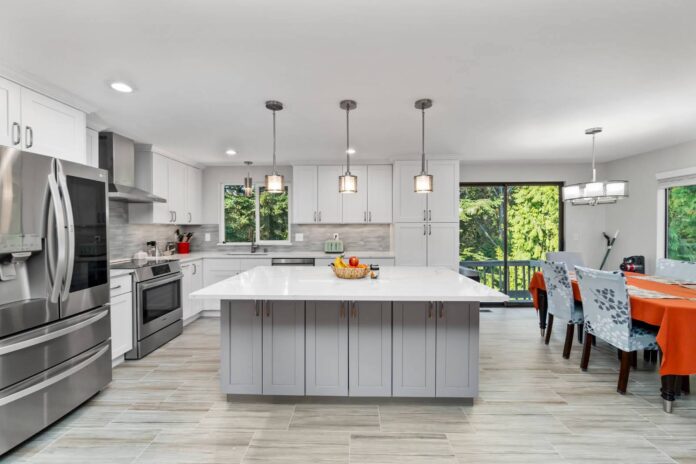A kitchen island can be the centerpiece of your kitchen, providing extra counter space, storage, and a place to gather. Whether you have a small or large kitchen, a well-designed island can make your cooking and entertaining experience much more enjoyable. Here’s a detailed guide on how to design a perfect kitchen island for your space.
1. Determine Your Needs
Before you start remodeling your kitchen, think about what you need it to do. Different people have different needs, and your island should be tailored to suit yours.
Common Uses for a Kitchen Island:
- Extra Counter Space: Ideal for meal prep, baking, or setting out dishes.
- Additional Storage: Cabinets, drawers, and shelves can help you organize your kitchen.
- Seating Area: A place for family and friends to sit and chat while you cook.
- Cooking Area: Include a cooktop or oven for added functionality.
- Cleaning Station: A sink or dishwasher can make clean-up easier.
2. Measure Your Space
Before you decide on the size and shape of your island, measure your kitchen to see how much space you have available. Make sure there is enough room to move around the island comfortably.
Tips:
- Walkway Space: Ensure there is at least 36-48 inches of space around the island for easy movement.
- Island Size: For small kitchens, a compact island (around 2-4 feet long) is best. Larger kitchens can accommodate bigger islands (5-7 feet long or more).
- Height: Standard counter height is about 36 inches, while bar height is around 42 inches.
3. Choose the Shape
Kitchen islands come in various shapes. Choose one that fits well in your kitchen and meets your needs.
Common Shapes:
- Rectangular: The most common and versatile shape, suitable for most kitchens.
- Square: Great for small kitchens or as an extra prep area.
- L-Shaped: Provides more counter space and can define different kitchen zones.
- U-Shaped: Ideal for larger kitchens, offering ample counter space and storage.
4. Select the Right Materials
The materials you choose for your kitchen island can affect its functionality and look. Consider both the countertop and the base materials.
Countertop Materials:
- Granite: Durable and heat-resistant, great for heavy use.
- Quartz: Non-porous and low maintenance, available in many colors.
- Wood (Butcher Block): Warm and inviting, perfect for a rustic look.
- Marble: Elegant and luxurious, though it requires more maintenance.
- Stainless Steel: Sleek and modern, easy to clean and very durable.
Base Materials:
- Wood: Classic and sturdy, can be painted or stained to match your kitchen.
- Metal: Adds an industrial touch, very durable.
- Laminate: Budget-friendly and available in various colors and patterns.
5. Incorporate Storage Solutions
Storage is a key feature of a functional kitchen island. Think about what you need to store and design your island accordingly.
Storage Options:
- Cabinets: Great for storing pots, pans, and larger items.
- Drawers: Ideal for utensils, cutlery, and smaller items.
- Open Shelves: Perfect for displaying dishes, cookbooks, or decorative items.
- Pull-Out Bins: Convenient for trash and recycling.
- Wine Racks: Add a wine rack if you enjoy collecting wine.
6. Add Seating
If you want your kitchen island to double as a dining or social area, consider adding seating. The type of seating depends on your kitchen’s size and your personal style.
Seating Options:
- Bar Stools: Tall and slim, ideal for a casual dining area.
- Chairs: More comfortable, great for a formal dining space.
- Bench Seating: Space-saving and perfect for families.
Tips:
- Overhang: Ensure the countertop extends 12-18 inches to provide legroom.
- Height: Match the height of your seating to the height of your island (counter height or bar height).
7. Include Appliances
For added functionality, consider incorporating appliances into your kitchen island. This can turn your island into a central hub for cooking and cleaning.
Appliance Options:
- Cooktop: Allows you to cook while facing the rest of the kitchen.
- Oven: Adds extra baking space.
- Microwave Drawer: Saves counter space and keeps the microwave accessible.
- Dishwasher: Makes cleaning up easier.
- Sink: Perfect for food prep and washing up.
8. Consider Electrical Outlets
Electrical outlets are essential for making your kitchen island more functional. They allow you to use small appliances like blenders, mixers, and toasters.
Tips:
- Placement: Install outlets on the sides of the island for easy access.
- USB Ports: Consider adding USB ports for charging devices.
- Pop-Up Outlets: Hidden when not in use, they keep the island looking sleek.
9. Think About Lighting
Proper lighting is crucial for making your kitchen island a functional and inviting space. Good lighting can enhance both the appearance and usability of your island.
Lighting Options:
- Pendant Lights: Stylish and functional, they provide focused light over the island.
- Recessed Lighting: Subtle and modern, ideal for general lighting.
- Under-Cabinet Lighting: Great for task lighting if your island has cabinets.
Tips:
- Height: Hang pendant lights about 30-36 inches above the island countertop.
- Spacing: Space multiple lights evenly for balanced illumination.
- Dimmer Switch: Install a dimmer switch for adjustable lighting.
10. Personalize Your Island
Finally, make your kitchen island uniquely yours by adding personal touches. Decorate it to reflect your style and make it a welcoming part of your home.
Ideas:
- Decorative Items: Add vases, bowls, or cookbooks.
- Plants: Bring in some greenery with small potted plants or herbs.
- Art: Hang artwork or photos on nearby walls to enhance the space.
- Color: Paint the island base in a color that complements your kitchen decor.
Conclusion
Designing the perfect kitchen island involves considering your needs, measuring your space, choosing the right shape and materials, and incorporating storage, seating, appliances, and lighting. With thoughtful planning and attention to detail, you can create a kitchen island that enhances your kitchen’s functionality and style, making it a central hub for cooking, dining, and socializing. Enjoy the process of designing your kitchen island and make it a beautiful, practical addition to your home.










